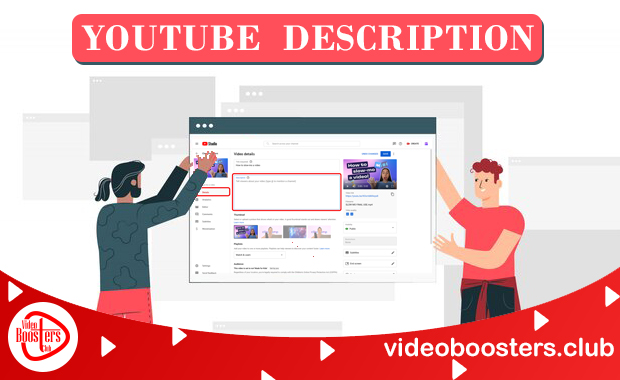
Creating compelling YouTube content involves more than just the video itself—it’s also about how you present that content to your audience. A well-crafted YouTube description can boost your video’s searchability, engage viewers, and encourage them to take action, ultimately improving your channel’s growth.
Despite its importance, many creators overlook this essential part of their content strategy. Here we’ll explain what a robust YouTube description should include and provide 10 practical tips on how to create catchy descriptions for your videos.
What is a YouTube Description?
A YouTube description is the text section below a YouTube video or on a channel’s “About” page, where creators provide additional information about the video content, links, and calls-to-action (CTAs). The description serves as an essential tool to give viewers context, share relevant resources, and guide viewers to engage further with the content or the creator’s brand.
In a YouTube video description, video content creators usually include:
- A brief summary of the video’s content.
- Keywords connected with the topic at hand will boost searchability.
- Links to social media profiles, websites, and related videos.
- Timestamps to help viewers navigate longer videos.
- CTAs entice audiences to become subscribers, like, or comment.
These descriptions also play a critical role in YouTube SEO, helping the platform understand what a video is about. Well-crafted descriptions can increase a video’s visibility, making it more likely to appear in YouTube’s search results and recommended sections, ultimately increasing more views and engagement.
Understanding the Importance of YouTube Descriptions
YouTube descriptions serve a dual purpose. They are not only a chance to communicate directly with viewers but also an opportunity to optimize for YouTube’s algorithm. Descriptions let YouTube learn about your content, elevate search ranks, and boost visibility. Viewers also rely on descriptions for additional context, links, and calls-to-action (CTAs). Thus, an effective YouTube description can lead to increased engagement, more views, and better retention.
10 Smart Tips to Create an Effective YouTube Description
1. Optimize Your First 100-150 Characters
The opening of your description is crucial as it’s the part that viewers see in search results and preview snippets. Using these characters wisely can significantly improve click-through rates.
- Include Primary Keywords Upfront: Placing your main keyword near the beginning signals to both viewers and YouTube algorithm what your video is about. For example, if your video is on “effective YouTube descriptions,” include that phrase early on to catch interest and increase search relevance.
- Craft a Compelling Hook: Draw viewers in by writing a hook that sparks curiosity. A question, bold claim, or surprising fact related to your content can work wonders.
- Avoid Redundant Information: Keep the initial lines tight and avoid repeating the video title or unnecessary words that don’t add value. This maximizes the impact of those first few lines.
2. Use Strategic Keyword Placement
Effective keyword placement can improve your video’s rank in search results. Strategic placement of keywords is essential to avoid keyword stuffing and still maintain readability.
- Research Relevant Keywords: Use YouTube’s auto-suggest, Google Keyword Planner, or tools like TubeBuddy to discover what your target audience is searching for. High-volume but low-competition keywords increase your reach.
- Incorporate Long-Tail Keywords: Phrases such as “how to write a YouTube description” or “beginner’s guide to YouTube descriptions” are more specific and help attract viewers looking for in-depth information.
- Balance Keyword Usage with Readability: Keyword stuffing can turn off viewers and even hurt rankings. Aim to use keywords naturally, weaving them into sentences that add value and make sense.
3. Create a Consistent Structure
A well-structured description improves readability and lets viewers quickly access relevant information. Creating a template for your video descriptions saves time and ensures uniformity across videos.
- Develop a Template for Your Descriptions: A template with sections for an intro, key points, and a CTA (call-to-action) simplifies the description-writing process. For example:
- Introduction: Brief overview of the content.
- Body: Detailed points or sections (use bullet points or short paragraphs for readability).
- End: CTAs and relevant links.
- Include Timestamps for Longer Videos: Timestamps allow viewers to navigate directly to parts of the video they’re interested in. This is especially helpful for tutorials or in-depth discussions.
- Maintain Brand Voice Across All Descriptions: Keep a consistent tone in your descriptions to strengthen brand identity. Whether your tone is professional or casual, a uniform voice builds viewer trust.
4. Add Relevant Links
Links are an essential part of your description as they guide viewers to additional resources and encourage deeper engagement with your brand.
- Include Social Media Profiles: Adding links to social media platforms gives viewers an easy way to follow you beyond YouTube. It can help you develop a more comprehensive online presence.
- Link to Your Website or Blog: If you have a blog post or webpage related to your video, include it in your description. This can boost your website’s traffic and connect viewers with more content.
- Promote Related Content on Your Channel: Linking to other videos or playlists keeps viewers on your channel longer. This increases watch time, a key metric YouTube uses to recommend content.
5. Incorporate Calls-to-Action (CTAs)
CTAs are prompts that encourage viewers to engage with your content further, either by subscribing, liking, commenting, or checking out related videos.
- Encourage Viewers to Subscribe: Add a direct CTA like “Don’t forget to subscribe for more content!” to help grow your subscriber base.
- Ask for Likes and Comments: Engaging viewers by asking for their thoughts in the comments can boost interaction and create a sense of community.
- Prompt Viewers to Check Out Other Videos: Suggesting related videos within your description can help keep viewers engaged on your channel and increase overall watch time.
6. Provide Value-Added Content
Extra content, such as transcripts, additional links, or summaries, can make your descriptions more informative and valuable to viewers.
- Offer Additional Resources: Share related blog articles, online courses, or other resources that complement your video content.
- Include Transcripts or Key Points: Adding key points or transcripts can help viewers understand the core ideas without watching the full video, especially for educational content.
- Share Behind-the-Scenes Information: Behind-the-scenes details or fun facts can create a more personal connection with your audience, especially if you’re building a community around your brand.
7. Optimize for Search Engines
SEO for YouTube is about helping YouTube’s algorithm understand your content better. Optimizing file names, titles, and tags improves the chances of ranking higher in search results.
- Use Descriptive File Names: Before uploading, name your file with a descriptive, keyword-rich title, as YouTube considers file names when assessing a video’s content.
- Include Relevant Tags: Tags provide additional context about your content and help YouTube match it with similar videos. Use primary keywords and include variations or relevant terms.
- Craft SEO-Friendly Titles: Use your primary keyword in the title to ensure it aligns with search queries. For example, “15 YouTube SEO Tips To Grow Your Channel” is specific and includes a main keyword.
8. Leverage Hashtags Effectively
Hashtags promote visibility and might help you link your content to popular and trending topics or themes.
- Research Popular and Relevant Hashtags: Stick to hashtags that are trending or closely related to your content. Research popular ones on YouTube and try using those alongside your branded tags.
- Limit Hashtag Usage to 3-5 per Description: Too many hashtags can distract viewers, and YouTube may not index descriptions with excessive tags. Stick to a few focused ones.
- Create Branded Hashtags for Your Channel: Having a unique hashtag for your brand makes it easy for viewers to find all your related content, fostering a sense of community around your brand.
9. Update Descriptions Regularly
Updating descriptions keeps them fresh and relevant, especially as content, promotions, or links change over time.
- Refresh Outdated Information: Remove old details or add updated links for new promotions, products, or events that may be relevant.
- Add New Links or Resources: If you have newer videos, blog posts, or resources that relate to an older video, update the description to include these for added value.
- Optimize Based on Performance Data: Track which descriptions drive the most engagement using YouTube Analytics. Tweak underperforming descriptions by adjusting keywords, CTAs, or links.
10. Comply with YouTube Policies
Following YouTube’s policies on content and metadata is essential to maintain your channel’s reputation and avoid penalties.
- Disclose Sponsored Content: Transparency with viewers is key. If you’re promoting a brand, make it clear to avoid potential backlash or policy violations.
- Avoid Misleading Tags or Metadata: Using irrelevant tags, keywords, or descriptions can mislead viewers and harm your rankings. Stick with tags that appropriately identify your content.
- Follow Community Guidelines: Ensure your descriptions are respectful and appropriate for all viewers. Misleading or inappropriate descriptions can lead to penalties or even removal.
Conclusion
Mastering YouTube descriptions can have a significant impact on your channel’s growth and viewer engagement. By following these 10 tips, you’ll be able to create descriptions that not only enhance your content but also contribute to your overall content strategy. Experiment with these practices, track your performance, and make adjustments as needed to keep your descriptions fresh, engaging, and optimized for success.


